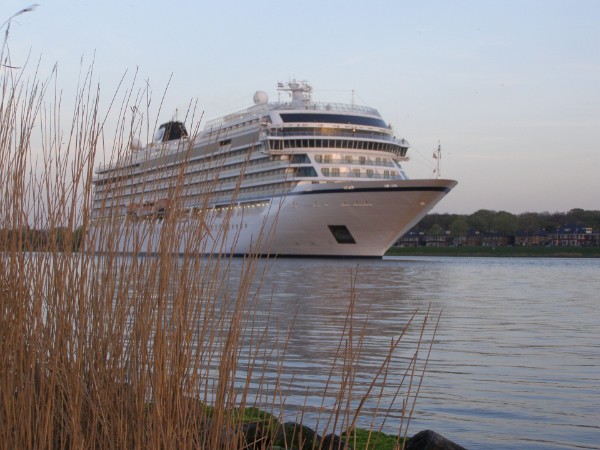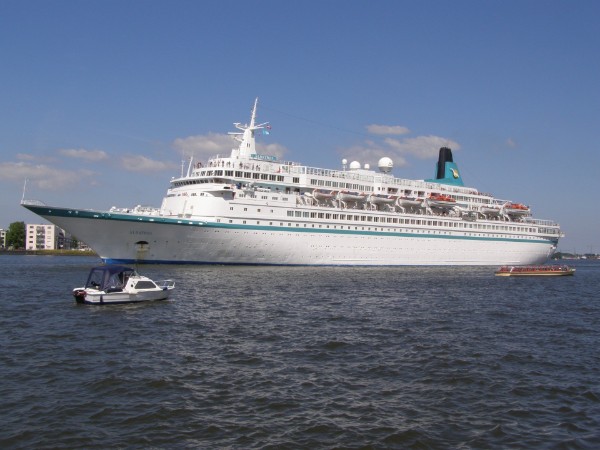Viking Sea
Background
In 2012, the company Viking River Cruises created a new branch within their portfolio, when they ordered two oceangoing cruiseships. They aimed at a traditional cruisepassenger who liked to sail in the same informal luxury style of their river cruiseships, but then at sea. The company is owned by Torstein Hagen, the former CEO of Royal Viking Line. This company had been operating luxury cruises between the beginning of the 1970's untill 1994, when RVL was finally absorbed into Cunard Line after ownership under Norwegian Cruise Line failed. So Hagen was not new to oceancruising, he had also been involved with Holland America Line and Kloster Cruise after he left RVL in 1984. But he had always been very fond of his former company and the style of the line overall.

Viking Sea was the thirth ship of Viking Ocean Cruises to visit The Netherlands and she did so at the 21st of april in 2018.
Again under his own ownership and backed by an impressive fleet of around 60 river cruiseships, the first two ships were to be the start-up for something bigger then a marginal company. And indeed, we have seen a rather quick expansion with the orders for more ships to the same layout as the first two ships were being built. As a little sentimental touch, the first ships recieved the names of the first ships of the Royal Viking Line in the early 1970's, also in the same order. So the first ship entered service in 2015 under the name of Viking Star (after the Royal Viking Star) and the second one became the Viking Sea (after the Royal Viking Sea). At the time the new Viking Ocean Cruises started its operations, all former Royal Viking Line ships were also still in service.
Construction and general statistics
The second Viking Ocean Cruises ship was built at the Marghera Yards of Fincantieri in Italy, just like her earlier sister. During building, she was known as yardnumber 6245. The first steel of the ship was cut in september of 2014 and at the 6th of november in 2014, the first buildingblock was lowered into position and a mere eight months later at the 25th of july 2015 the floatout took place. The ship was finally delivered to the company at the 24th of march 2016.
Viking Sea measures 47.842 tons and has a capacity of 944 passengers and 602 crewmembers at her 14 decks. She has a lenght of 227,20 meters, is 28.80 meters wide and has a draft of 6,30 meters. She can sail at a speed of 20 knots and is driven by two 12-cylinder and 2 9-cylinder diesel engines of Fyra MAN design. The ship does have the exact same measurements and design as her earlier fleetmate Viking Star and her later counterparts Viking Sky, Viking Sun, Viking Orion and Viking Jupiter. The order was extended later up untill 2027, when a total of 17 ships of this class will be in service. It will be the largest class ever in cruiseship history.

Design and style
Not only the measurements are the same as those of Viking Star, the interiours of both ships are also almost identical. Just in later ships, several minor adjustments were made with the knowledge about which spaces work and which don't. The overall design of the ships was carried out by the London-based SMC Design, together with the Los Angeles-based Rottet Studios for the interiours.
As for environmentfriendlyness, the ship runs on energy-sufficient hybrid engines and has so-called scrubbersystems installed in her exhausts to minimalize harmfull emissions. The streamlined hull provides fuel-efficiency and solar panels are used aboard to reduce fossil fuels even more. The propellershafts of the ship are lubricated by seawater, that can be recycled into the ocean without doing harm to the ecosystem. In looks, the ships inherits several design elements of the former Royal Viking Line ships from which they got their names and inspiration. The long, sharp bow is something clearly reminding of these 1970's-built ships, as we do not see that often in todays competitive world. Also the blue line between the lower hull and the superstructure is a direct link to the former Royal Viking Line.
Royal Viking Sea was the true name-giver to the second ship in the Viking Ocean fleet. She now sails under the name of Albatros for the German Phoenix Cruises.

Inside, the ship is designed in true no-nonsense semi-luxury Scandinavian style, light cream and white natural colours are used to create a very open feeling in the public spaces and cabins. Just like companies like Oceania Cruises, it hints back to the 'older' days of cruising, without losing modernity on smaller-sized ships. Of course the main hub of the ship is a three-deck high atrium where music is sometimes performed in classical style, as well as music from the regions the ships sail in. With probably the exception of Scandinavian heavy metal is my guess...
The theater at deck 2 is of course hosting performances, but is also used for lectures and cooking classes which tend to be very popular among Viking Cruises passengers. Dining can be done in several restaurants, mainly The Restaurant at deck 2 and the World Café at deck 7. At deck 2, The Restaurant also features a terrace where you can dine outside, but this didn't seem that popular and was changed in the later ships. Mamsen is a Scandinavian-style deli alternative, named fondly after Torstein Hagen's mother.
The ship also has a piano lounge, two cinema's, a wraparound promenade deck, gymnasium and Spa-area's and of course a swimmingpool that can be covered by a sliding roof. Hey, they are still smart Scandinavians and know that weather is not always good enough to swim under the open Viking skies during their number of European cruises.

Carreer
At the 3rd of april in 2016, the ship started her Maiden Voyage departing Istanbul for Venice. She was named in the center of London close to Greenwich at the 5th of may in 2016 by Karine Hagen, one of Torstein's two daughters. Afterwards, the ship settled in for a series of European and Baltic cruises, and she didn't tie up to a routine sceme as the ships of Viking Ocean roam the seas just like their earlier counterparts of Royal Viking Line had done before. Also the Mediterranean was visited in her first year, where she suffered some engine troubles two times in the end of 2016. In august, she lost power close to Malta and in december, as if they liked it, it again happened in Barcelona. Furthermore, after some troubles the company had experienced (maybe not that strange for a company transisting from rivers to the sea), passengers seem to really enjoy the quiet time and style of the company. This was mostly reflected in the quick order for more ships of the same design.

